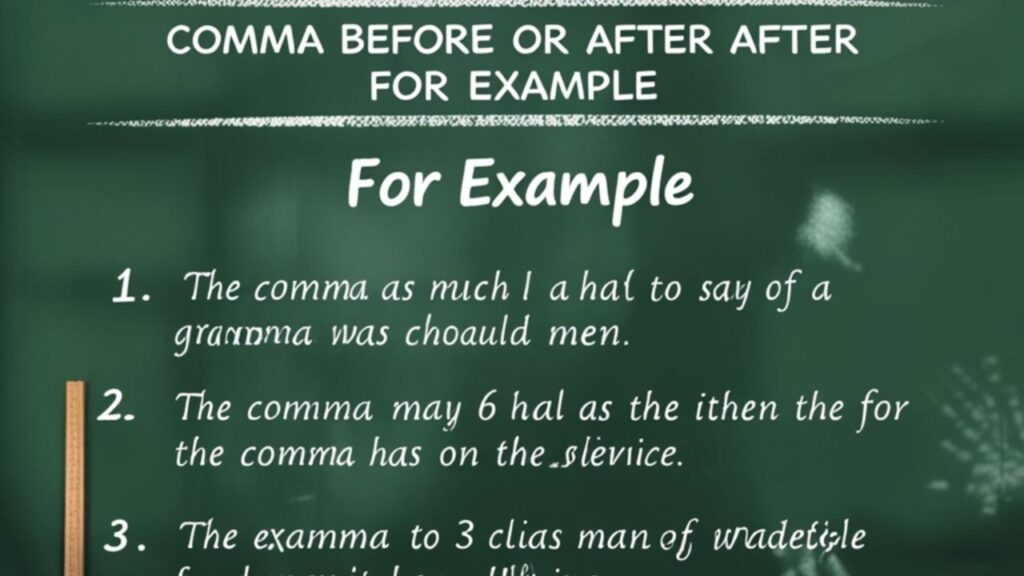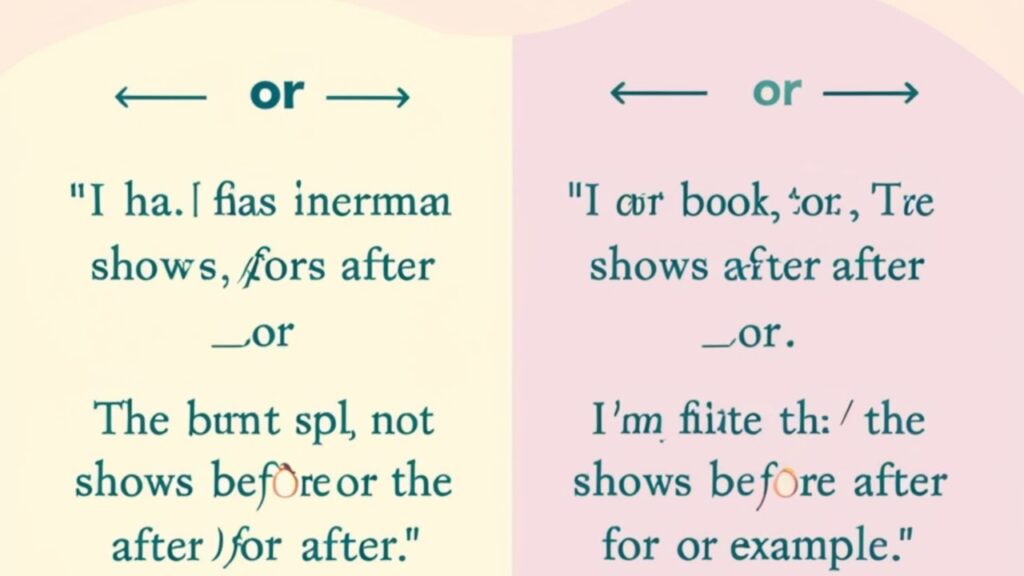Understanding comma before or after “for example” helps make sentences clear and easy to read. Writers use it to separate ideas, introduce examples, and guide readers smoothly. Correct punctuation keeps writing professional and avoids confusion in both formal and casual texts.
Placing a comma before or after “for example” depends on its position. When it starts a sentence, a comma usually follows. When it appears in the middle, commas both before and after create a natural pause. This rule improves readability and sentence flow.
Using comma before or after “for example” also works in lists and explanations. It signals that what follows illustrates or supports the main idea. Proper use ensures your writing looks polished and helps readers understand points without effort.
What Does “For Example” Do in Writing?
The phrase for example helps writers give clear illustrations or details. It shows readers exactly what is meant and makes ideas easier to understand. Using it properly improves writing and ensures sentences feel smooth and organized.
In writing, for example connects statements to real situations or lists. It guides readers by pointing out specific cases. Proper use highlights important points and makes communication more effective, whether in stories, essays, or online posts.
Difference Between “For Example” and Similar Phrases
The phrase for example differs from similar words like such as, like, or e.g. It introduces clear examples and often needs commas. Other phrases can show examples too, but their punctuation and tone change depending on how writers use them.
Using for example is more formal and direct than words like like. It guides readers to understand a point clearly. Phrases such as such as work inside sentences, while e.g. appears in parentheses, showing careful differences in meaning and style.
| Phrase | Use Case | Comma Usage Example |
| For example | Introducing an illustration or example | Many fruits are tropical, for example, mangoes and papayas. |
| Such as | Introducing examples within a list | Tropical fruits, such as mangoes and papayas, are delicious. |
| Like | Informal comparison | Tropical fruits like mangoes are sweet. |
| E.g. | Latin abbreviation meaning “for example” | Tropical fruits (e.g., mangoes and papayas) are popular worldwide. |
Core Rules for Using Commas with “For Example”
Correct comma placement is essential for readability and grammar. Here are the core rules for commas around “for example”:
When to Use a Comma Before “For Example”
Use a comma before “for example” when it introduces a list or explanation after a complete sentence. This pause helps readers notice the examples and keeps writing clear, smooth, and easy to understand in essays, stories, or online posts.
Placing a comma before “for example” signals that additional details follow. It separates the main idea from the examples, making sentences readable. This simple punctuation rule guides readers naturally and improves the overall flow of writing without confusing the message.
- Place a comma before for example when it introduces a list that explains the previous statement.
- Use a comma if for example follows a full sentence or independent clause.
- Add a comma to signal a pause, helping readers understand an illustration or clarification.
- Include a comma before for example when it connects ideas smoothly in compound sentences.
- Use it to separate the main point from the supporting examples for clarity and flow.
When to Use a Comma After “For Example”
Place a comma after “for example” when it starts a sentence or clause. This pause separates the phrase from the rest of the sentence, making writing easier to read and helping readers follow ideas clearly in stories, essays, or online posts.
Using a comma after “for example” keeps sentences neat and professional. It signals that an illustration or list will follow. This small punctuation helps maintain smooth flow and ensures the main idea stays connected to the supporting details.
- Place a comma after for example when it starts a sentence to separate it from the main idea.
- Use a comma after for example when introducing a clause or list that explains the statement.
- Add a comma to create a natural pause, making the sentence easier to read.
- Include a comma after for example in formal writing to maintain clarity and professional tone.
- Use it when for example acts as an introductory phrase for smooth flow in writing.
When to Use Commas Both Before and After (“Parenthetical Use”)
Use commas both before and after “for example” when it appears in the middle of a sentence. This parenthetical style separates the phrase from the main idea, making the sentence clear, smooth, and easy for readers to follow.
The parenthetical use of commas helps highlight examples without breaking the sentence. It keeps writing neat and professional, guiding readers to the details. This method ensures that supporting points are noticeable while maintaining the flow of the main statement.
- Use commas on both sides when for example appears in the middle of a sentence as extra information.
- Add commas to separate the phrase from the main clause for smooth reading and clarity.
- Place commas when for example interrupts a sentence without changing its main meaning.
- Include commas to highlight illustrative or clarifying details that enhance the main point.
- Use this format in formal and informal writing to keep sentences balanced and professional.
When NOT to Use a Comma with “For Example”
Avoid using a comma with “for example” when it is tightly linked to the sentence without a natural pause. Adding a comma in this case can make the sentence awkward and interrupt the smooth flow of ideas for readers.
Knowing when not to use a comma helps writing stay clean and easy to read. It keeps the sentence connected and ensures that examples follow naturally, making the message clear without unnecessary breaks or confusion for the audience.
- Do not add a comma when for example appears at the end of a sentence without extra words after it.
- Avoid a comma if for example smoothly connects to the sentence without needing a pause.
- Leave out a comma when it directly follows a preposition, such as like or such as.
- Do not use a comma if it makes the sentence look broken or harder to read.
- Skip the comma when writing in very short, simple sentences where no pause is needed.
See also : Throwing Shade Meaning, Examples & Pop Culture Guide
Positioning “For Example” in a Sentence

The placement of “for example” influences comma use. Here’s a breakdown:
At the Beginning of a Sentence
When for example starts a sentence, place a comma right after it. This pause helps readers understand that an illustration or detail will follow. Using this style keeps writing clear, professional, and easy for everyone to read.
Starting a sentence with for example makes ideas stand out. The comma separates the phrase from the main point and guides readers smoothly to the supporting details. This simple rule improves clarity and ensures sentences feel organized and easy to follow.
Mid-Sentence Placement
When for example appears in the middle of a sentence, place commas both before and after it. This style separates the phrase from the main idea and makes sentences easier to read, clear, and organized for everyone.
Mid-sentence placement helps highlight examples without breaking the flow. Using commas correctly guides readers smoothly through the sentence, showing which part is the main idea and which part is supporting information or illustration.
At the End of a Sentence
Placing for example at the end of a sentence usually does not need a comma. The phrase follows the main idea and shows an illustration clearly. This keeps writing simple, smooth, and easy to understand for all readers.
Using at the end of a sentence emphasizes the example without interrupting the main point. This placement works best when the supporting detail naturally follows the idea, keeping sentences organized and professional while guiding readers through the information clearly.
Common Sentence Structures Involving “For Example”
Understanding how “for example” interacts with sentence structures makes your writing smoother.
Serial Lists and Commas with “For Example”
When using for example with serial lists, place a comma before it to signal the start of examples. Then separate each item in the list with commas. This method keeps writing clear, organized, and easy for readers to follow.
Serial lists and commas with “for example” make details stand out. The phrase guides readers to understand specific examples while keeping the sentence smooth. Correct punctuation ensures the list is easy to read and that the main idea stays connected to supporting points.
Clauses and Compound Sentences
In clauses and compound sentences, for example introduces a part that explains or supports the main idea. Place commas correctly to separate the example from the rest of the sentence. This keeps writing clear, smooth, and easy for readers to follow.
Using for example in compound sentences helps connect ideas with illustrations. Proper punctuation shows which part is the main point and which part is the supporting detail. This makes reading easier and ensures sentences remain organized and professional.
Parentheses and Dashes with “For Example”
- Use parentheses around for example when adding extra information quietly within a sentence.
- Choose dashes when you want stronger emphasis or a dramatic pause around for example.
- Place for example in parentheses when the detail feels less central to the main idea.
- Use dashes if the example is important and you want it to stand out clearly.
- Both parentheses and dashes help vary sentence style, but dashes give more impact while parentheses keep it subtle.
Common Mistakes and How to Avoid Them
Even experienced writers slip up with commas and “for example.” Here are pitfalls to watch out for:
Overusing Commas Around “For Example”
Overusing commas around “for example” can make sentences confusing and awkward. Too many pauses break the flow and make reading difficult. Using commas only when needed keeps writing smooth, clear, and easy for readers to follow.
Limiting commas around “for example” helps highlight the examples correctly. Proper punctuation guides readers through sentences without distractions. This careful use ensures writing stays professional, neat, and easy to understand while keeping the main idea connected to supporting details.
Confusing “For Example” with “E.g.” Punctuation Rules
Many writers confuse for example with e.g. because both introduce illustrations. For example usually appears in a sentence with commas, while e.g. often goes inside parentheses. Understanding the difference keeps writing clear, professional, and easy to follow.
Using e.g. versus for example correctly ensures examples are shown in the right format. For example guides readers through sentences, while e.g. gives a brief, parenthetical illustration. Proper punctuation avoids mistakes and makes writing smooth and organized.
See also : Thanks Everybody vs Thanks Everyone: Correct Grammar Guide
Misplaced Commas That Disrupt Meaning
Misplaced commas that disrupt meaning can change what a sentence says and confuse readers. Incorrect punctuation may make statements unclear or funny. Using commas in the right spots keeps writing smooth, clear, and easy for everyone to understand.
Correct placement of commas that disrupt meaning ensures sentences flow naturally. Proper punctuation separates main ideas from examples or details. This simple rule makes writing professional, readable, and helps readers follow the message without mistakes or misunderstandings.
- Placing a comma between the subject and verb makes the sentence confusing and grammatically wrong.
- Adding a comma before essential information can separate ideas that must stay connected.
- Using a comma before restrictive clauses (that-clauses) changes the intended meaning.
- Inserting commas randomly within short phrases breaks the natural flow of the sentence.
- Putting commas before verbs or objects without reason interrupts clarity and weakens the message.
Style and Readability Considerations
Beyond grammar, comma placement affects how your writing sounds and feels.
Balancing Traditional Rules with Conversational Tone
Balancing traditional rules with conversational tone helps writing feel natural and easy to read. Following grammar rules keeps sentences correct, while a friendly tone makes them engaging. This balance ensures writing is clear, professional, and enjoyable for readers.
Using a conversational tone with traditional rules guides readers smoothly through examples and ideas. Proper punctuation supports clarity, while simple, friendly language connects with the audience. This approach keeps writing organized, readable, and professional without sounding stiff or formal.
How Comma Placement Affects Reader Understanding
How comma placement affects reader understanding is important for clear writing. Correct commas guide readers through sentences, showing where pauses belong and which parts explain or support the main idea. This keeps writing smooth, easy to read, and professional.
Placing commas carefully prevents confusion and misreading. Proper punctuation highlights examples and separates ideas clearly. Using commas correctly helps readers follow the message naturally, making writing organized, clear, and enjoyable without disrupting the flow or meaning of the sentences.
When to Prioritize Readability Over Strict Rules
Prioritize readability over strict rules when following grammar strictly makes sentences awkward or hard to follow. Clear, smooth writing helps readers understand ideas easily. Adjusting commas slightly can make text feel natural while keeping meaning correct and professional.
Focusing on readability in writing allows ideas to flow without unnecessary pauses. Proper punctuation is important, but sometimes skipping a strict rule improves clarity. This approach ensures sentences remain easy to read, organized, and engaging for all readers.
Advanced Scenarios with “For Example”

Advanced scenarios with “for example” occur when sentences include multiple ideas or nested details. Proper commas and punctuation keep these sentences clear, helping readers understand complex information while maintaining smooth flow and professional, easy-to-read writing.
Using for example in complex sentences highlights supporting details without confusing readers. Correct placement ensures that each example connects to the main idea, guiding the audience through intricate information while keeping writing organized, neat, and readable.
Handling Multiple Examples and Nested Punctuation
Handling multiple examples and nested punctuation requires careful placement of commas and parentheses. Each example should be separated clearly to avoid confusion. Proper punctuation keeps sentences organized, making complex information easy to read, smooth, and professional.
Using nested punctuation with examples ensures that supporting details stand out without breaking the flow. Correctly placing commas, dashes, or parentheses guides readers through multiple illustrations, keeping writing clear, readable, and easy to understand while maintaining proper sentence structure.
Examples from Published Writing
Examples from published writing show how professional authors use for example with correct commas. Newspapers, books, and online articles place the phrase carefully to separate main ideas from supporting illustrations, making sentences clear, smooth, and easy for readers to follow.
Studying published writing examples helps writers understand proper punctuation and sentence flow. Observing how authors set off examples guides readers through ideas naturally while keeping writing organized, professional, and readable, making complex points simpler to understand.
Quick Reference Guide: Comma Placement with “For Example”
| Position in Sentence | Comma Placement | Example |
| Beginning | Comma after “for example” | For example, many people like hiking. |
| Middle (parenthetical) | Comma before and after | Many fruits, for example, apples, are sweet. |
| End | Usually no comma | Many people enjoy fruits,for example. (Avoid; awkward) |
| Before “for example” | Comma before when introducing an example | Many sports, for example, soccer and tennis, are popular. |
Conclusion:
In conclusion, using for example correctly makes writing clear and easy to read. Proper commas guide readers through ideas smoothly. Following these simple rules improves sentences, highlights examples, and keeps writing professional, neat, and understandable for everyone.
Mastering for example punctuation helps writers connect main ideas with illustrations. Correct use of commas ensures clarity, flow, and organization. Practicing these rules makes writing stronger, easier to follow, and more engaging for readers across essays, stories, or online content.
FAQS:
Do you put a comma after for
No, you don’t normally put a comma after for. It works as a conjunction linking ideas, so adding a comma is unnecessary.
How do I put for example in a sentence
Use for example inside a sentence with commas: “I like fruits, for example, apples and bananas.” It introduces specific details clearly.
Do you put a colon after saying “for example”
No colon is needed after for example. Instead, follow it with a comma to smoothly introduce supporting words, phrases, or examples.
Should I use a comma before eg
Yes, always place a comma before e.g. in formal writing. Example: “You should eat more vegetables, e.g., carrots, spinach, or peas.”

Join Bibcia on a journey to master English grammar. Discover easy lessons, writing tips, and practical examples designed to make learning grammar simple and effective.










